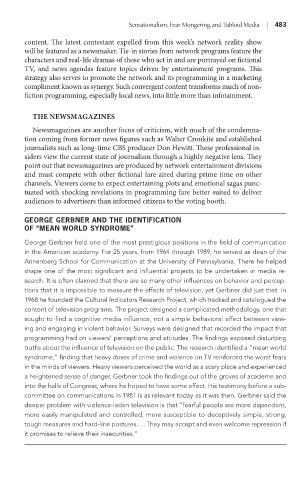Page 504 - Battleground The Media Volume 1 and 2
P. 504
Sensat onal sm, Fear Monger ng, and Tablo d Med a |
content. The latest contestant expelled from this week’s network reality show
will be featured as a newsmaker. Tie-in stories from network programs feature the
characters and real-life dramas of those who act in and are portrayed on fictional
TV, and news agendas feature topics driven by entertainment programs. This
strategy also serves to promote the network and its programming in a marketing
compliment known as synergy. Such convergent content transforms much of non-
fiction programming, especially local news, into little more than infotainment.
ThE nEwsmagazinEs
Newsmagazines are another focus of criticism, with much of the condemna-
tion coming from former news figures such as Walter Cronkite and established
journalists such as long-time CBS producer Don Hewitt. These professional in-
siders view the current state of journalism through a highly negative lens. They
point out that newsmagazines are produced by network entertainment divisions
and must compete with other fictional fare aired during prime time on other
channels. Viewers come to expect entertaining plots and emotional sagas punc-
tuated with shocking revelations in programming fare better suited to deliver
audiences to advertisers than informed citizens to the voting booth.
george gerBner and the identiFiCation
oF “Mean world syndroMe”
George Gerbner held one of the most prestigious positions in the field of communication
in the American academy. For 25 years, from 1964 through 1989, he served as dean of the
Annenberg School for Communication at the University of Pennsylvania. There he helped
shape one of the most significant and influential projects to be undertaken in media re-
search. It is often claimed that there are so many other influences on behavior and percep-
tions that it is impossible to measure the effects of television, yet Gerbner did just that. In
1968 he founded the Cultural Indicators Research Project, which tracked and catalogued the
content of television programs. The project designed a complicated methodology, one that
sought to find a cognitive media influence, not a simple behavioral effect between view-
ing and engaging in violent behavior. Surveys were designed that recorded the impact that
programming had on viewers’ perceptions and attitudes. The findings exposed disturbing
truths about the influence of television on the public. The research identified a “mean world
syndrome,” finding that heavy doses of crime and violence on TV reinforced the worst fears
in the minds of viewers. Heavy viewers perceived the world as a scary place and experienced
a heightened sense of danger. Gerbner took the findings out of the groves of academe and
into the halls of Congress, where he hoped to have some effect. His testimony before a sub-
committee on communications in 1981 is as relevant today as it was then. Gerbner said the
deeper problem with violence-laden television is that “fearful people are more dependent,
more easily manipulated and controlled, more susceptible to deceptively simple, strong,
tough measures and hard-line postures. . . . They may accept and even welcome repression if
it promises to relieve their insecurities.”

